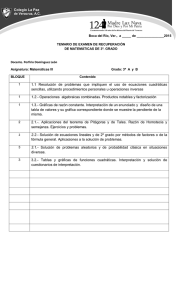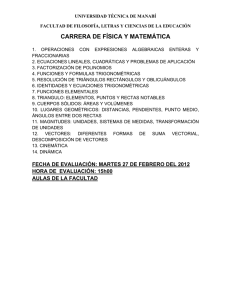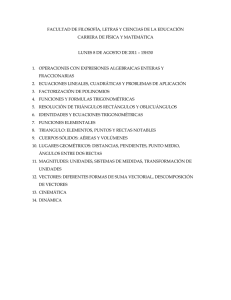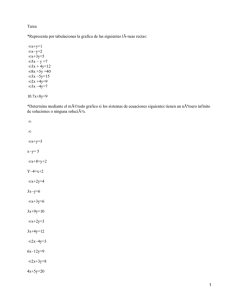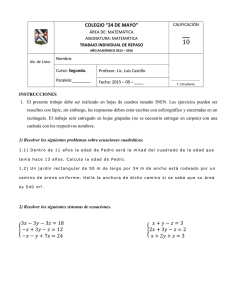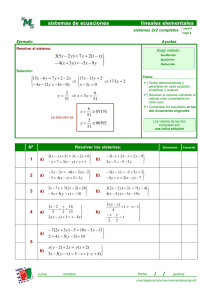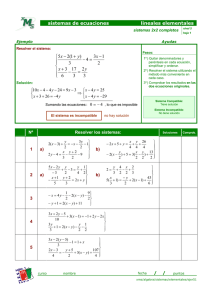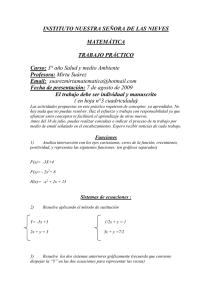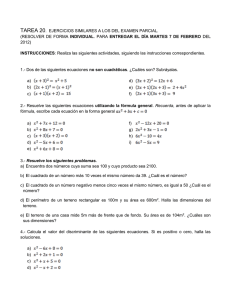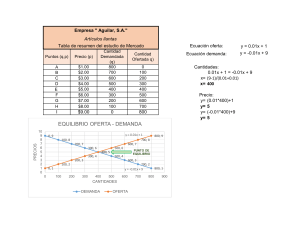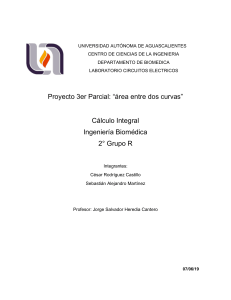1.- Tabule y grafique las siguientes funciones: utilice 0 ≤ x ≤ 5 a) y
Anuncio
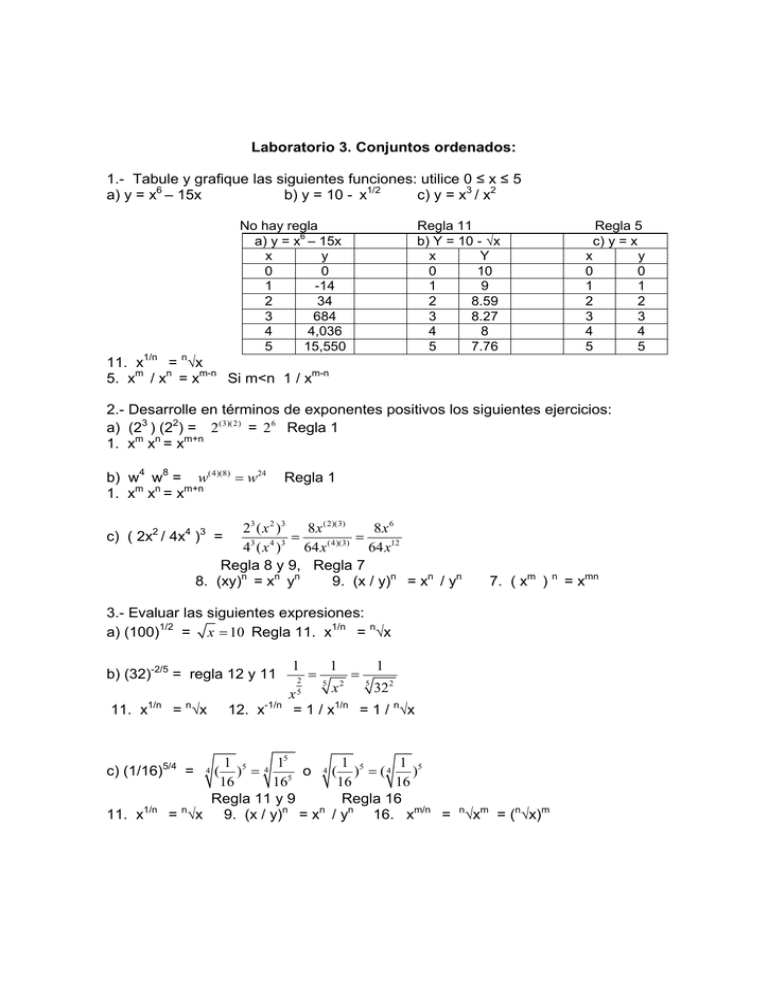
Laboratorio 3. Conjuntos ordenados:
1.- Tabule y grafique las siguientes funciones: utilice 0 ≤ x ≤ 5
b) y = 10 - x1/2
c) y = x3 / x2
a) y = x6 – 15x
No hay regla
a) y = x6 – 15x
x
y
0
0
1
-14
2
34
3
684
4
4,036
5
15,550
Regla 11
b) Y = 10 - √x
x
Y
0
10
1
9
2
8.59
3
8.27
4
8
5
7.76
11. x1/n = n√x
5. xm / xn = xm-n Si m<n 1 / xm-n
Regla 5
c) y = x
x
y
0
0
1
1
2
2
3
3
4
4
5
5
2.- Desarrolle en términos de exponentes positivos los siguientes ejercicios:
a) (23 ) (22) = 2(3)(2) = 26 Regla 1
1. xm xn = xm+n
b) w4 w8 = w(4)(8) = w24
1. xm xn = xm+n
Regla 1
23 ( x 2 )3 8 x (2)(3)
8x6
=
=
43 ( x 4 )3 64 x (4)(3) 64 x12
Regla 8 y 9, Regla 7
8. (xy)n = xn yn
9. (x / y)n = xn / yn
c) ( 2x2 / 4x4 )3 =
7. ( xm ) n = xmn
3.- Evaluar las siguientes expresiones:
a) (100)1/2 = x = 10 Regla 11. x1/n = n√x
b) (32)-2/5 = regla 12 y 11
11. x1/n = n√x
2
5
=
1
5
2
=
1
5
x
322
x
= 1 / x1/n = 1 / n√x
1
15
1
1
( ) 5 = 4 5 o 4 ( )5 = ( 4 )5
16
16
16
16
Regla 11 y 9
Regla 16
= n√x 9. (x / y)n = xn / yn 16. xm/n = n√xm = (n√x)m
c) (1/16)5/4 =
11. x1/n
12. x-1/n
1
4
Ejercicios para clase:
1. 6(3 0 ) = 6(1) = 6
2
3
34
81
2. −( ) −4 = −( ) 4 = −( 4 ) = −
3
2
2
16
1
1
3. −4−2 = −(4) −2 = 2 =
−4 16
1
= x −4
4.
x4
5. −( x 4 ) 2 = − x (4)(2) = x8
6. (
7.
2 x3 −2
2 x8 −2
3 2
32
9
=
=
=
= 16
)
(
)
(
)
8
2
(8)(2)
−5
3x
3
2x
(2) ( x
) 4x
x2 y
x2 y 1
1 1 1
=
= x 2 y ( )( )( 3 ) = x 2 y (9−1 )( w−1 )( z 3 )
(
)
3
3
9wz
1 9wz
9 w z
1. 3{2x[2x+3]+5[4x2-(3-4x)]} = 72 x 2 + 78 x − 45
2. (6 x 2 − 10 xy + 2) − (2 z − xy + 4) = 6 x 2 − 9 xy − 2 z + 2 − 4
3. ( x + 2 y ) + ( x + 3 z ) = 2 x + 2 y + 3 z
4. ( x + 2 y ) − ( x + 3 z ) =
2 y − 3z
5. (x+2)(x-5) = x 2 − 3x − 10
6. ( x + 4)( x + 5) = x 2 + 9 x + 20
7. (2t-3)(5t2+3t-1) = 10t 3 − 9t 2 + 11t + 3
8. 3(3x + 2 y − 5) − 2(8 x − 4 y + 2) = −7 x + 14 y − 19
9. 3( x 2 + y 2 ) − x( y + 2 x) + 2 y ( x + 3 y ) = x 2 + 9 y 2 + xy
{
}
10. 2 3 ⎡⎣3 ( x 2 + 2 ) − 2 ( x 2 − 5 ) ⎤⎦ = 6 x 2 + 96 = 6 x 2 + 126
{
}
11. −3 4 x ( x + 2 ) − 2 ⎡⎣ x 2 − ( 3 − x ) ⎤⎦ = −6 x 2 − 18 x − 18
{
}
12. x 3( x − 1)( x − 2) + 2 ⎡⎣ x ( x + 7 ) ⎤⎦ = 5 x3 + 5 x 2 + 6 x
13. ( 2 y + 3) = 2 y + 6 2 y + 9
2
14.
(
x +2
)(
)
x −2 = x−4
15. 3 3 + 4 x y − 5 3 − 11x y −
3
1
− ⎞
⎛ 1
16. x 2 ⎜ x 2 − x 2 ⎟ = x 2 − x
⎝
⎠
2
1
5
2
⎛ 1
⎞
17. ⎜ x 2 − x 3 ⎟ = x − 2 x 6 + x 3
⎝
⎠
z 2′ − 4 z
18.
= z−4
z
(
)
3 − x y = −3 3 − 6 x y
19.
20.
21.
22.
23.
24.
25.
26.
27.
5x
−15 x 2 y 3
=− 2
5
3 xy
y
x3 + 3x x3 3x
= +
= x2 + 3
x
x
x
6 x5 + 4 x3 − 1
1
= 3x3 + 2 x − 2
2
2x
2x
3x2 − 4 x + 3
7
= x−2+
3x + 2
3x + 2
3
2 x − 14 x − 5
7
= 2x2 + 6x + 4 +
x −3
x −3
3
4 x − 13 x − 22
47
= 4 x 2 + 12 x + 23 +
x−3
x −3
3
x + 2x + 7
79
= x 2 + 4 x + 18 +
x−4
x−4
3
2
4x + 4x + 5
−2 x + 3
= 2x + 2 + 2
2
2x + 1
2x + 1
3
3
2
(8 xy )( 2 x y )( −3xy ) = −48 x5 y 6
Reglas de Factorización:
Teorema fundamental de aritmética: un número natural n>1, o es primo, o se puede
expresar como un producto de factores primos en forma única (excepto por el orden de los
factores) o bien como un producto de potencias primas:
24 = 2(12) = 2(2)(6) = 2(2)(2)(3) = 23(3)
24
24
2
12
6
4
2
2
2
2
3
6
2
3
Ejemplo: D24 = {x/x es divisor de 24} = {1, 24, 3, 8, 2,12, 4, 6}
D36 = {x/x es divisor de 36} = {1,36, 3, 12, 4, 9, 18, 2, 6}
1.- Factor común:
a) xy + xz = x(y+z)
Ejemplo: 6 y 3 + 3 y 2′18 y = 3 y ( 2 y 2 + y − 6 )
b) x 2 + ( a + b ) x + ab = ( x + a )( x + b )
⎛ 13 ⎞⎛ 13
⎞
Ejemplo: x − 5 + 4 = ⎜ x − 1⎟⎜ x − 4 ⎟
⎝
⎠⎝
⎠
2
3
1
3
c) abx 2 + ( ab + cb ) x + cd = ( ax + c )( bx + d )
Ejemplo: 9 x 2 + 9 x + 2 = ( 3 x + 1)( 3 x + 2 )
2.- Trinomio cuadrado perfecto
2
2
a) x 2 + 2ax + a 2 = ( x + a )
Ejemplo: x 2 + 8 x + 16 = ( x + 4 )
b) x 2 − 2ax + a 2 = ( x − a )
2
Ejemplo: x 2 − 6 x + 9 = ( x − 3)
2
3.- Diferencia de dos cuadrados
a) x 2 − a 2 = ( x + a )( x − a ) Ejemplo: x 4 − 1 = ( x 2 + 1)( x 2 − 1) = ( x 2 + 1) ( x + 1)( x − 1)
4.- Suma de dos cubos: x3 + a 3 = ( x + a ) ( x 2 − ax + a 2 )
Ejemplo: ( x 3 + 13 ) = ( x + 1) ( x 2 − 1x + 13 )
5.- Diferencia de dos cubos: x3 − a 3 = ( x + a ) ( x 2 + ax + a 2 )
Ejemplo: 8 − 3x 2 = 23 − x3 = ( 2 − x ) ( 4 + 2 x + x 2 )
Matemáticas 1: Prof. Gerardo Gutiérrez Jiménez
1
Ejercicios para clase:
1.- 10xy + 5xz = 5x(2y+2)
2.- 8a 3bc − 12ab3cd + 4b 4 c 2 d 2 = 4abc ( 2a 2 − 3b 2 d + b3cd 2 )
3.- x 2 − 25 = ( x + 5 )( x − 5 )
4.- p 2 + 4 p + 3 = ( p + 1)( p + 3)
5.- 16 x 2 − 9 = 4 x ( 4 x − 9 )
6.- z 2 + 6 z + 8 = ( z + 2 )( z + 4 )
7.- x 2 + 6 x + 9 = ( x + 3)( x + 3) = ( x + 3)
2
8.- 2 x 2 + 12 x + 16 = ( 2 x + 4 )( x + 4 )
9.- 3 x3 − 3 = 2 x ( 6 x 2 + 5 x − 4 ) = 2 x ( 3 x + 4 )( 2 x − 1)
10.- 3 x 2 − 3 = ( 3 x + 3)( x − 1)
11.- 6 y 2 + 13 y + 2 = ( 6 y + 1)( y + 2 )
12.-
2 x3 + 2 x 2 − 12 x = 2 x ( x 2 + x − 6 ) = 2 x ( x − 2 )( x + 3)
2 x ( x + 3)( x − 2 )
13.- ( 4 x + 2 ) = 4 ( 2 x + 1)
2
Propiedad conmutativa
2
14.- Desarrolle x3 y 2 − 10 x 2 y + 25 x = x ( xy − 5 )
2
15.- Desarrolle x3 + 8 = ( x + 2 ) ( x 2 − 2 x + 4 )
16.- Desarrolle hasta obtener: x 6 − 1 = ( x + 1) ( x 2 − x + 1) ( x − 1) ( x 2 + x + 1)
Matemáticas 1: Prof. Gerardo Gutiérrez Jiménez
2
Laboratorio No. 5. Factorización:
Realice la factorización para cada uno de los siguientes ejercicios, en una hoja
aparte. Dado que las respuestas acompañan al documento, deberá desarrollar los
ejercicios e indicar la razón (regla) que lo fundamenta.
1. 6 y 2 − 4 y =
2. 3 x 2 y − 9 x 3 y 3 =
3. 6 z 2t 3 + 3zst 4 − 12 z 2t 3 =
4. x 2 + 3 x − 4 =
5. s 2 − 6s + 8 =
6. x 2 + 5 x − 24 =
7. y 2 − 15 y + 50
8. 2 x 2 + 7 x − 15 =
9. 4 y 2 − 8 y + 3 =
10. 4 x 2 − x − 3 =
11. 9 z 2 + 24 z + 16 =
12. x 2 y 2 − 4 xy + 4 =
13. ( x 2 − 1) + ( x 2 − x − 2 ) =
14. x3 y − xy + z 2 x 2 − z 2 =
15. x 3 − 1 =
16. 27 + 8x3 =
1. 2 y ( 3 y − 2 )
2. 3 xy ( x − 3 x 2 y 2 )
Respuestas:
9. ( 2 y − 1)( 2 y − 3)
10.
3. 3 zt ( 2 zt 2 + 5t 3 − 4 zt 2 )
11.
4. ( x − 1)( x + 4 )
12.
5. ( s − 4 )( s − 2 )
13.
6. ( x − 3)( x + 8 )
7. ( y − 5 )( y − 10 )
8. ( 2 x + 3)( x − 5 )
( 4 x + 3)( x − 1)
( 3z + 4 )
( xy − 2 )( xy − 2 )
( x − 1)( x + 1) + ( x − 2 )( x + 1)
2
14. x ( x 2 y − y + z 2 x ) − z 2
15. ( x − 1) ( x 2 + x + 1)
16. ( x + 3) ( x 2 − 3 x + 9 )
No olvide poner su nombre en la parte superior comenzando por su apellido paterno
Matemáticas 1: Prof. Gerardo Gutiérrez Jiménez
3
Ejercicios adicionales
“no son para revisar, ni tienen un valor sobre la calificación, son ejercicios para realizar en
casa de manera voluntaria”.
Fracciones:
x2 − 5x − 6
12 x 2 − 19 x + 4
=
2.
=
1. 2
x − 2x − 3
6 x 2 − 17 x + 12
c+d
−9 x 3
5. c
6. x =
c−d
3
2c
y
2
9.
− 2
=
2
3y − 5y − 2 3y − 7 y + 2
z2 − 4
z2
*
3. 2
z + 2z z − 2
x2 − 4
2
7. x 2+ 2 x − 3 =
x − x−6
x2 − 9
x 2 − y 2 x 2 + 2 xy + y 2
4.
*
x+ y
x− y
2
x
+
=
8.
x+2 x+2
10. ( x −1 + y −1 ) =
2
Ecuaciones Lineales:
7 + 2 ( x + 1) 8 x
=
3
5
4. 6 − 2 x + 5 = 0
1.
8.
1 1 4
+ =
x 5 5
x 2 ( x − 4)
+
=7
5
10
5. 4 x − 6 = x
2.
9.
2x − 3
=6
4x − 5
3
( 4 x − 3) = 2 ⎡⎣ x − ( 4 x − 3) ⎤⎦
2
4
3
5
6.
7. = 25
=
t −3 t −4
x
10. z − 2 = 3
3.
Ecuaciones cuadráticas:
1. x 2 + 9 x = −14
5.
6 ( w + 1)
w
+
=3
2−w
w −1
9.
x − 2x − 8 − 2 = 0
2.
1 2 3
y = y
7
7
6. x + x − 2 = 0
3.
7.
5−
10.
0.01x 2 + 0.2 x − 0.6 = 0
x 6
= −1
3 x
3 ( x + 3) 1 − x
=
x 2 + 3x
x
4.
2
6
−
=5
x −1 2x +1
8.
3 x+4 = x−6
Ejercicios adicionales
“no son para revisar, ni tienen un valor sobre la calificación, son ejercicios para realizar en
casa de manera voluntaria”.
Fracciones:
x2 − 5x − 6
12 x 2 − 19 x + 4
=
2.
=
1. 2
x − 2x − 3
6 x 2 − 17 x + 12
c+d
−9 x 3
5. c
6. x =
c−d
3
2c
y
2
9.
− 2
=
2
3y − 5y − 2 3y − 7 y + 2
z2 − 4
z2
*
3. 2
z + 2z z − 2
x2 − 4
2
7. x 2+ 2 x − 3 =
x − x−6
x2 − 9
x 2 − y 2 x 2 + 2 xy + y 2
4.
*
x+ y
x− y
2
x
+
=
8.
x+2 x+2
10. ( x −1 + y −1 ) =
2
Ecuaciones Lineales:
7 + 2 ( x + 1) 8 x
=
3
5
4. 6 − 2 x + 5 = 0
1.
8.
1 1 4
+ =
x 5 5
x 2 ( x − 4)
+
=7
5
10
5. 4 x − 6 = x
2.
9.
2x − 3
=6
4x − 5
3
( 4 x − 3) = 2 ⎡⎣ x − ( 4 x − 3) ⎤⎦
2
4
3
5
6.
7. = 25
=
t −3 t −4
x
10. z − 2 = 3
3.
Ecuaciones cuadráticas:
1. x 2 + 9 x = −14
5.
6 ( w + 1)
w
+
=3
2−w
w −1
9.
x − 2x − 8 − 2 = 0
2.
1 2 3
y = y
7
7
6. x + x − 2 = 0
3.
7.
5−
10.
0.01x 2 + 0.2 x − 0.6 = 0
x 6
= −1
3 x
3 ( x + 3) 1 − x
=
x 2 + 3x
x
4.
2
6
−
=5
x −1 2x +1
8.
3 x+4 = x−6
Ejercicios para la clase: (cancelación)
2x2 + 6x − 8
1.=
8 − 4 x − 4 x2
2 ( x 2 + 3x − 4 )
4(2 − x − x
2 ( x − 1)( x + 4 )
2 ( 2 ) ⎡⎣( −1)( x − 1) ⎤⎦ ( 2 + x )
2
=
)
=
2 ( x − 1)( x + 4 ) 2 ( x − 1)( x + 4 )
=
=
4 (1 − x )( 2 + x ) 4 ⎡⎣( −1)( x − 1) ⎤⎦
x+4
x+4
=−
ó
−2 ( 2 + x )
2 ( x + 2)
( 2 x − 2 )( x + 4 ) = ( 2 x − 2 )( x + 4 ) =
x+4
x+4
=−
( −2 x + 2 )( 2 x + 4 ) ⎡⎣ −1( 2 x − 2 )⎤⎦ ( 2 x + 4 ) ( −1) ⎡⎣ 2 ( x + 2 )⎤⎦ 2 ( x + 2 )
2.-
( x − 3)( x + 2 ) = 1( x + 2 ) = x + 2
x2 − x − 6
=
2
x − 7 x + 12 ( x − 3)( x − 4 ) 1( x − 4 ) x − 4
x − ( x + h)
−h
( x)1
1( x + h)
1
1
−
−
( x)( x + h) x ( x + h )
x ( x + h)
x ( x + h)
=
=
=
3.- x + h x =
h
h
h
h
1
− h (1)
1
1
=−
=− 2
x ( x + h) h
x ( x + h)
x + xh
4
4
y 4 + y ( y + 4 ) 4 + y 2 + 4 y ( y + 2 )( y + 2 ) ( y + 2 )
4.+y=
+ =
=
=
=
1( y + 4 )
y+4
y+4 1
y+4
y+4
y+4
2
4x
4 x ( x − 1)
4x ⎛ x −1 ⎞
4x
5.- x2 − 1 = 2 ⎜ 2
=
=
⎟
2 x + 8 x x − 1 ⎝ 2 x + 8 x ⎠ ⎡⎣( x + 1)( x − 1) ⎤⎦ ⎡⎣ 2 x ( x + 4 ) ⎤⎦ ( x + 1) ⎡⎣ 2 x ( x + 4 ) ⎤⎦
x −1
2
=
6.-
2
( x + 1)( x + 4 )
( x − 1)( x − 4 ) − x ( x + 2 ) =
x2 − 5x + 4
x2 + 2 x
−
=
2
2
x + 2 x − 3 x + 5 x + 6 ( x − 1)( x + 3) ( x + 2 )( x + 3)
( x − 4) − x = x − 4 − x = 4
x−4
x
−
=
x+3 x+3
x+3
x+3
x+3
7.-
−4 ( x − 2 )
x2 − 5x + 4 x2 − 2
−4 x + 8
x2 − 5x + 4 x2 − 2
−
+ 2
=
−
+
=
x−7
x − 7 x − 9 x + 14
x−7
x − 7 ( x − 2 )( x − 7 )
(x
2
+ x − 5 ) − ( x 2 − 2 ) + ( −4 )
x−7
=
x2 + x − 5 − x2 + 2 − 4 x − 7
=
=1
x−7
x−7
3( x2 )
2 ( x − 3)
2
3
8.- 3
+
=
+
=
x ( x − 3) x ( x − 3)2 x3 ( x − 3)( x − 3) ( x 2 ) x ( x − 3)2
( 2 x − 6 ) + ( 3x 2 ) 2 x − 6 + 3x 2
=
= 3
2
2
x 3 ( x − 3)
x ( x − 3)
=
3x 2 + 2 x − 6
x 3 ( x − 3)
2
2
x ( x − 1) − 4 ( 3 x + 2 ) ( x − x ) − (12 x − 8 )
4
x
x 2 − 13x − 8
9.−
=
=
=
3x + 2 x − 1
( 3x + 2 )( x − 1)
( 3x + 2 )( x − 1)
( 3x + 2 )( x − 1)
10.( x − 1)( x − 4 ) − x ( x + 2 ) = x − 4 − x = ( x − 4 ) − x = − 4
x2 − 5x + 4
x2 + 2 x
−
=
2
2
x + 2 x − 3 x + 5 x + 6 ( x − 1)( x + 3) ( x + 2 )( x + 3) x + 3 x + 3
x+3
x+3
x −5
x−5
2
( x − 5)( x − 2 ) = x − 2 = 1
11.- x − 7 + 10 =
x−2
x−2
x−2
( x − 2 )( x + 2 ) ( x − 2 )( x + 2 )
x2 − 4
2
( x − 1)( x + 3) = ( x − 1)( x + 3) = ( x − 2 )( x + 2 )( x + 3) = x − 2
12.- x 2+ 2 x − 3 =
x+2
x − x−6
( x + 2 )( x − 3)
( x − 1)( x + 3)( x + 2 ) x − 1
2
x+3
x −9
( x − 3)( x + 3)
13.-
14.-
15.-
2 x − 3 2 − x ( 2 x − 3)( 2 − x ) −4 x − 2 x 2 − 6 + 3x 2 x 2 − x − 6
=
=
=
=1
.
x − 2 2 x + 3 ( x − 2 )( 2 x + 3) 2 x 2 + 3x − 4 x − 6 2 x 2 − x − 6
3
−9 x3 −9 x ( 3) −27 x3
=
=
= −27 x 2
x
1( x )
x
3
4
4 1( x ) 4
x2
x 4 − x −x + 4
−
= 2−
= 2− 2 = 2 =
2
2
x
x −1 x
x ( x) x
x
x
x2
16.- 1 −
1( x 2 − 1)
1
1
x2
x2
x2
x2 − 1 − x2
=
−
=
−
=
=− 2
2
2
2
2
2
x − 1 1 x − 1 1( x − 1) x − 1
x −1
x −1
1( x 2 − 1) − ( x 2 ) x 2 − x 2 − 1
x2
1
1
= − 2
=
=
=− 2
2
2
x −1
x −1
1 x −1
1( x − 1)
17.-
18.-
y 4 + y ( y + 4 ) 4 + y 2 + 4 y ( y + 2 )( y + 2 ) ( y + 2 )
4
4
+y=
+ =
=
=
=
y+4
y+4 1
y+4
y+4
y+4
1( y + 4 )
(
)
( ) ( )
4 5− 2
⎛ 5− 2⎞
4
4
=
⎜⎜
⎟⎟ =
2
5+ 2
5+ 2⎝ 5− 2⎠
5 − 2
2
=
4
(
5− 2
5−2
) = 4(
2
5− 2
3
)
Laboratorio 6: Fracciones:
1.-
x2 − 4
=
x2 − 2 x
2.-
x 2 − 9 x + 20
=
x 2 + x − 20
3.-
6x2 + x − 2
=
2 x 2 + 3x − 2
⎛ y 2 ⎞ ⎛ −1 ⎞
4.- ⎜
⎟⎜
⎟=
⎝ y − 3 ⎠⎝ y + 2 ⎠
⎛ 2 x − 3 ⎞⎛ 2 − x ⎞
5.- ⎜
⎟⎜
⎟=
⎝ x − 2 ⎠⎝ 2 x + 3 ⎠
6.-
x2
5x + 6
+
=
x+3 x+3
7.-
4
x
+
=
2x −1 x + 3
4x
8.- 3 =
2x
Funciones:
Función: elemental para el estudio del cálculo. Una función es un tipo especial de relación
de entrada y salida, o insumo y producto, que expresa cómo una cantidad (la salida) depende de
otra cantidad (entrada). Ejemplo, la cantidad de ingresos en un negocio, depende del volumen de
ventas.
Definición: Una función es una regla que asigna a cada número de entrada exactamente un
número de salida. El conjunto de todos los números de entrada a los cuáles se aplica la regla se
denomina dominio de la función. Al conjunto de todos los números de salida se le llama ámbito o
contradominio.
f(x) que se le “f de x” significa el número de salida en el ámbito de f que corresponde al
número de entrada x en el dominio.
f(x) donde x=entrada y f(x) la salida.
Ejemplo f(x) = x + 2
Para encontrar la salida de la entrada 3, se reemplaza 3 en cada x. por lo tanto:
F(3)= 3 + 2 y esto nos da: F(3) = 5
Advertencia: f(x) NO significa f multiplicado por x, sino la salida que corresponde a la entrada x.
El dominio consiste en todos los números reales para los que la ecuación tiene sentido y
produce valores funcionales que son números reales.
h ( x) =
1
x−6
Aquí, cualquier número real exceptuando el 6, es valido. El 6 no puede ser posible puesto
que convierte el denominador en cero.
g ( t ) = 2t − 1
Se debe evitar tener raíces cuadradas negativas, por lo tanto 2t – 1 debe ser mayor o igual que
cero.
En una expresión tal como: f(x) = x – 3
A la totalidad de la expresión se denomina argumento de la función,
“y” es la variable de salida o variable dependiente, concerniente al ámbito o cotradominio.
“x” es la variable independiente. Concerniente al dominio.
El valor de “y” cuando se le aplicó un valor “x” se denomina imagen. El conjunto de todas las
imágenes se conoce como rango, que es el conjunto de todos los valores que toma la variable “y”.
Ejemplo: y = 150 + 7x
El dominio: 0 ≤ x ≤ 100 Dominio = {x/ 0 ≤ x ≤ 100}
Contradominio: 150 ≤ y ≤ 850 por lo tanto, {y/150 ≤ y ≤ 850}
Dominio
x
0
10
20
30
…
100
Contra
dominio
y
150
220
290
360
…
850
Funciones lineales
f ( x) = 3
f ( x ) = −2
y
-2.0
4.0
-1.5
-1.0
-0.5
0.0
y
0.5
1.0
1.5
2.0
x
-1.2
3.5
-1.4
-1.6
-1.8
3.0
-2.0
-2.2
2.5
-2.4
-2.6
-2.8
-2.0
-1.5
-1.0
-0.5
0.0
0.5
1.0
1.5
2.0
-3.0
x
f ( x) = x + 7
f ( x) = x − 3
y
-2.0
9
-1.5
-1.0
-0.5
0.0
y
0.5
1.0
1.5
2.0
8
-2
7
-3
6
-4
-2.0
-1.5
-1.0
-0.5
0.0
0.5
1.0
1.5
2.0
f ( x) = 2x + 3
y
7
6
-1.5
-1.0
-5
f ( x) = 2x − 3
y
-2.0
x
-2.0
-1.5
-1.0
1
-0.5
0.5
5
-1
4
-2
3
-3
2
-4
1
-5
-0.5
0.5
-1
1.0
1.5
2.0
-6
x
-7
1.0
1.5
2.0
x
x
Funciones Cuadráticas
f ( x ) = x2
f ( x ) = − x2
y
-2.0
4
-1.5
-1.0
-0.5
0.0
y
3
0.5
1.0
1.5
2.0
x
-1
2
-2
1
-3
-4
-2.0
-1.5
-1.0
-0.5
0.0
0.5
1.0
1.5
2.0
x
f ( x ) = x2 + 2
f ( x ) = x2 − 2
y
y
6
2
5
1
4
-2.0
-1.5
-1.0
-0.5
0.5
1.0
1.5
2.0
x
3
-1
-2.0
-1.5
-1.0
-0.5
0.0
0.5
1.0
1.5
2.0
x
-2
f ( x ) = − x2 + 2
f ( x ) = − x2 − 2
y
-2.0
2
1
-1.5
-1.0
-0.5
0.0
y
-3
-4
-2.0
-1.5
-1.0
-0.5
0.5
-1
1.0
1.5
2.0
x
-5
-6
-2
0.5
1.0
1.5
2.0
x
f ( x ) = x 2 − 4 x − 12
-2
-1
0
y
1
f ( x ) = x2 − 8x
2
3
4
5
6
x
0
y
1
2
3
4
5
6
7
0.5
1.0
1.5
8
x
0
-2
-2
-4
-4
-6
-6
-8
-8
-10
-10
-12
-12
-14
-14
-16
-16
f ( x ) = −3 x 2 − 8 x + 6
y
10
8
6
4
2
-3.5
-3.0
-2.5
-2.0
-1.5
-1.0
-0.5
0.5
1.0
-2
x
-4
Funciones Cúbicas
f ( x ) = x3
f ( x ) = − x3
y
y
8
6
6
4
4
2
2
-2.0
-1.5
-1.0
8
-0.5
0.5
-2
1.0
1.5
2.0
-2.0
x
-1.5
-1.0
-0.5
-2
-4
-4
-6
-6
-8
-8
2.0
x
f ( x ) = x3 + 2
f ( x ) = − x3 + 2
y
-2.0
-1.5
-1.0
y
10
10
8
8
6
6
4
4
2
2
-0.5
0.5
1.0
1.5
2.0
-2
-2.0
-1.5
-1.0
-0.5
0.5
x
-4
-4
-6
-6
f ( x ) = x3 − 2
y
6
4
-1.0
2.0
-0.5
6
2
0.5
1.0
1.5
2.0
-2
x
-2.0
-1.5
-1.0
-0.5
0.5
1.0
1.5
2.0
-2
-4
-4
-6
-6
-8
-8
-10
-10
Funciones Simétricas
f ( x) = x
f ( x) = x
y
y
2.0
1.5
2
1
1.0
-2.0
-1.5
-1.0
-0.5
0.5
0.5
-1
-2.0
-1.5
-1.0
x
4
2
-1.5
1.5
f ( x ) = − x3 − 2
y
-2.0
1.0
-2
-0.5
0.0
0.5
1.0
1.5
2.0
x
-2
1.0
1.5
2.0
x
x
f ( x) = −x
f ( x) =
y
2
2
hiperbólica rectangular a > 0
x
y
14
12
10
1
8
6
4
2
-2.0
-1.5
-1.0
-0.5
0.5
1.0
1.5
2.0
x
-2.0
-1.5
-1.0
-0.5
-2
0.5
1.0
1.5
2.0
x
-4
-1
-6
-8
-10
-12
-2
-14
-16
Funciones no algebraicas
f ( x ) = 2x
f ( x ) = Logb x Logarítmicas
Exponencial
y
y
4
-2.0
-1.5
-1.0
-0.5
0.5
-1
3
-2
-3
-4
2
-5
-6
1
-7
-8
-2.0
-1.5
-1.0
-0.5
0.0
0.5
1.0
1.5
2.0
x
-9
-10
1.0
1.5
2.0
x
Problema: Un fabricante vende productos a un precio de $10 por unidad, sus costos fijos son de 1000 por
mes, sus costos variables son de $2 por unidad. ¿Cuántos productos debe vender el fabricante para no caer
en pérdidas?
Ingreso: Precio por cantidad 10x
Costos: Costos variables + costos fijos: 2x + 1000
10x = 2x + 1000
x= 1000 / 8
x = 125
Ingresos 10x
x
y
0
0
100 1000
125 1250
150 1500
Costos 2x + 1000
x
y
0
1000
100
1200
125
1250
150
1300
Problema: Cinemex, analiza la posibilidad de incrementar sus ingresos vía una disminución del precio, para
ello realiza los cálculos necesarios. Observa qué con 15 personas que ingresan a ver una película con un
precio de $20, obtiene $300. Dicha empresa quiere bajar el precio en $0.50 por persona adicional y de esta
forma aumentar sus ganancias. ¿Será esto viable? ¿Hasta que punto puede ser o no redituable?
Incremento de
personas (a)
0
1
2
…
10
11
12
Total de personas
(b)
15
(15 + 1) = 16
(15 + 2) = 17
Reducción del
precio (c)
0 = 20
0.5(1) = 0.5
0.5(2) = 1
20 – 0 = 20
20 – 0.5 = 19.5
20 – 1 = 19
(a)(d) = 300
(a)(d) = 312
(a)(d) = 323
(15 + 10) = 25
(15 + 11) = 26
(15 +12) = 27
0.5(10) = 5
0.5(11) = 5.5
0.5(12) = 6
20 – 5 = 15
20 – 5.5 = 14.5
20 – 6 = 14
(a)(d) = 375
(a)(d) = 377
(a)(d) = 378
13
14
15
…
X
(15 + 13) = 28
(15 + 14) = 29
(15 + 15) = 30
…
(15 + x) =
0.5(13) = 6.5
0.5(14) = 7
0.5(15) =7.5
20 – 6.5 = 13.5
20 – 7 = 13
20 – 7.5 = 12.5
(a)(d) = 378
(a)(d) = 377
(a)(d) = 375
0.5(x) = 0.5x
(20 – 0.5x)
(15 + x) (20 – 0.5x)
40
(15 + 40) = 55
0.5(40)=20
20 – 20 = 0
(a)(d) = 55 (0) = 0
( x + 15 )( −0.5 x + 20 ) =
x1 = −15
x2 =
Vértice:
⎛ −b ⎞
x=⎜ ⎟
⎝ 2a ⎠
Nuevo precio (d)
Ingreso
−0.5 x 2 + 20 x − 7.5 x + 300 = −0.5 x 2 + 12.5 x + 300
−20
= 40 Donde se encuentran los ceros.
−0.5
⎛ ⎛ −b ⎞ ⎛ − b ⎞ ⎞
( x, y ) = ⎜ ⎜ ⎟ , f ⎜ ⎟ ⎟
⎝ ⎝ 2a ⎠ ⎝ 2a ⎠ ⎠
⎛ −b ⎞
y= f⎜ ⎟
⎝ 2a ⎠
y = −0.5 (12.5 ) + 12.5 (12.5 ) + 300
x=
y = −78.13 + 156.25 + 300 = 377.87
2
y
300
200
100
-15
-10
− (12.5 ) −12.5
=
= 12.5
2 ( −0.5 )
−1
-5
0
5
10
15
20
25
30
35
40
x
